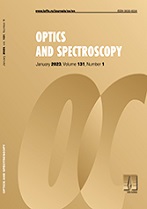|
This article is cited in 3 scientific papers (total in 3 papers)
Optics of low-dimensional structures, mesostructures, and metamaterials
Electroluminescence anode aluminum oxide in ketones
D. S. Ovechenko, A. P. Boychenko
Kuban State University, Krasnodar
Abstract:
The film of aluminum oxide formed by electrolysis in distilled water demonstrated the possibility of generating its electroluminescence in ketones and related compounds containing carbonyl groups. For acetone, cyclohexanone, methylpyrrolidone, acetylacetone, 4-ethylpropiophenone and 4-methoxypropiophenone, it was established that this process proceeds without electrolysis of the above compounds. It was shown that at constant voltage and temperature, the brightness-kinetic characteristics of luminescence are significantly affected by a combination of the following factors: the structure and elemental composition of hydrocarbon radicals of ketones, the number of carbonyl groups at these radicals, the thickness and structural organization of Al$_2$O$_3$ oxide films, on the surface of which local amplification is possible electric field strengths up to values of the order of 10$^6$ V/m, sufficient to initiate and maintain ionization processes leading to generation light.
Keywords:
Aluminium oxide, electroluminescence, anodizing, distilled water, ketones.
Received: 08.10.2019
Revised: 08.10.2019
Accepted: 21.10.2019
Citation:
D. S. Ovechenko, A. P. Boychenko, “Electroluminescence anode aluminum oxide in ketones”, Optics and Spectroscopy, 128:2 (2020), 256–262; Optics and Spectroscopy, 128:2 (2020), 250–256
Linking options:
https://www.mathnet.ru/eng/os477 https://www.mathnet.ru/eng/os/v128/i2/p256
|


| Statistics & downloads: |
| Abstract page: | 50 | | Full-text PDF : | 20 |
|





 Contact us:
Contact us: Terms of Use
Terms of Use
 Registration to the website
Registration to the website Logotypes
Logotypes








 Citation in format
Citation in format 
